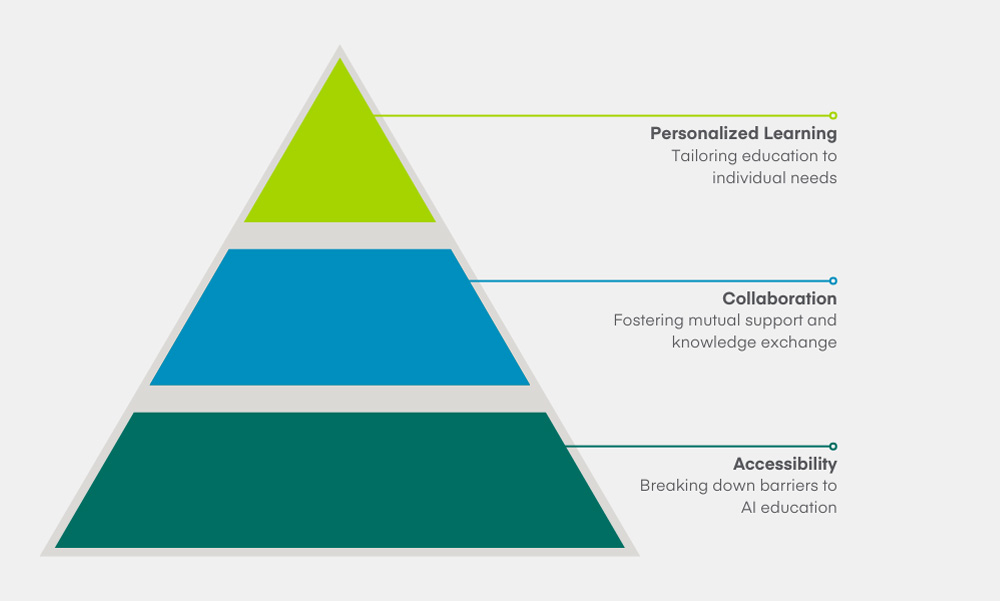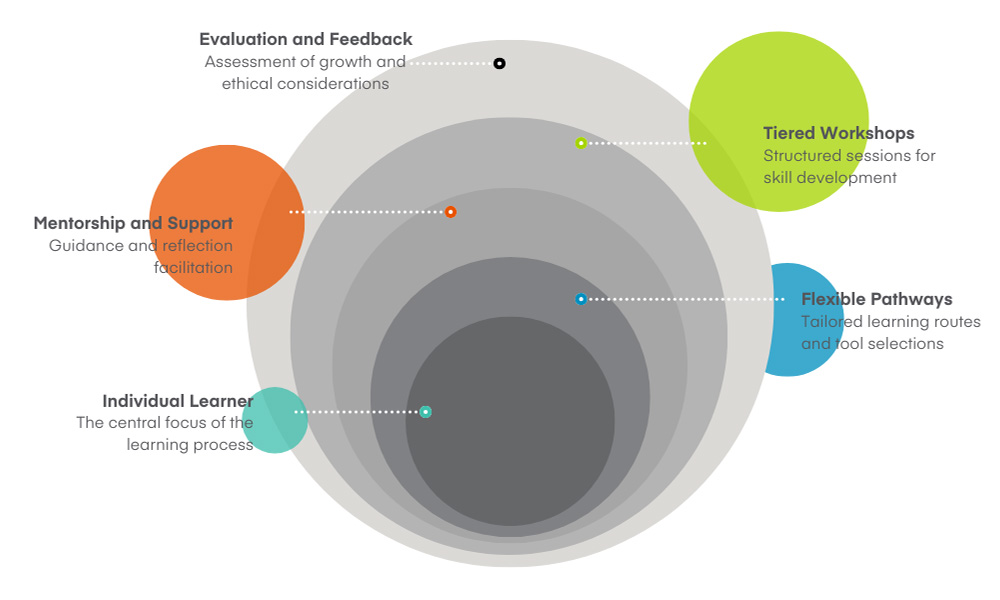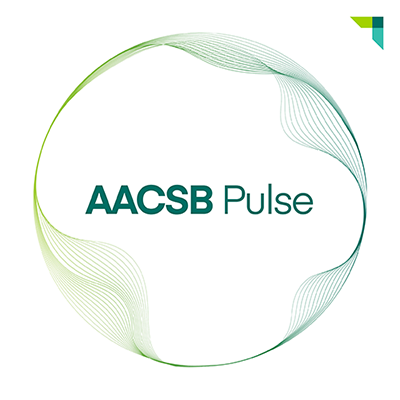Inclusive AI Literacy in Business Education
- Educators have developed a cross-institutional framework designed to empower students to use AI in ways that promote digital confidence, critical thinking, and ethical awareness.
- The model incorporates accessibility audits, peer-led mentoring, and co-designed assignments that foster cultures of shared learning, ethical reflection, and equitable use of technology.
- Workshops tailored to different skill levels, diagnostic assessments, and reflective journaling drive engagement with AI tools while addressing individual student needs.
As artificial intelligence (AI) reshapes higher education and the workplace, business schools must adopt digital transformation strategies that not only uphold academic excellence but also advance equity. Recently, I led a cross-institutional project driven by this imperative. Using funds from the Quality Assurance Agency for Higher Education (QAA), we developed a scalable framework to embed inclusive, ethical, and sustainable AI literacy into higher education.
We grounded this foundation on three core principles: accessibility, collaboration, and personalized learning. Through our model, we want to empower learners to develop the digital confidence, critical thinking, and ethical awareness necessary for success in an AI-driven world.
The Making of Our Model
True digital empowerment begins with inclusive design. Therefore, as a first step, accessibility audits were conducted across the eight European universities involved in our project.
These audits were overseen by education teams and learning technology units to ensure all tools met the needs of diverse learners. Some teams focused on the extent to which our programs promoted inclusive education, while others evaluated the effectiveness of our educational technology.
The audit teams at each university included not only faculty, but also student ambassadors, including disabled and multilingual students. The students helped faculty members evaluate new technologies before rollout. This collaborative approach ensured that our model was directly shaped by the lived experiences of those often left behind by digital innovation.
The Inclusive AI Literacy Pyramid

Accessibility: Breaking Down Barriers
To ensure that that AI literacy content is available to all students, regardless of their abilities or learning styles, each university incorporated several accommodations. These included:
- Offering learning materials in multiple formats, including text, audio, video, and interactive content. For instance, AI workshops use captioned video tutorials, audio summaries for screen-free review, and printable step-by-step PDFs for students who prefer written instructions.
- Integrating multilingual glossaries and AI-powered translation features into core platforms, so that students can engage with learning materials in their preferred languages. Faculty are encouraged to provide culturally adaptive examples during lessons.
- Embedding disability accommodations systematically in digital systems. These include screen reader-compatible interfaces, adjustable font sizes, keyboard navigation options, and text-to-speech tools. Institutions use orientation sessions and digital dashboards to proactively inform students about available accommodations.
During the pilot, each university tracked how and how often students used each accommodation through anonymous surveys and learning analytics generated by learning management system dashboards, clickstream data, and assessment submission logs. We found that approximately 25 percent of students involved in the pilot actively accessed accommodations. Many of these students were mature, multilingual, or first-generation learners.
These insights helped inform further customizations and training priorities. For example, universities found that some students were unaware of available AI tools, prompting improved communication strategies. Other students benefited most from peer mentoring and reflective tasks, leading to the expansion of these elements in future iterations.
Participating universities found that some students were unaware of available AI tools, prompting improved communication strategies, while other students benefited most from peer mentoring and reflective tasks.
To fill any knowledge gaps among faculty, as well as to address faculty resistance to incorporating these accommodations, institutions implemented both mandatory and voluntary professional development sessions. Sessions included interactive modules showcasing real student challenges with inaccessible tech, workshops on universal design for learning, and co-facilitated feedback forums where students shared their experiences directly with staff.
These feedback loops did not just foster a continuous improvement culture. They also bridged the gap between policy and practice.
Collaboration: Learning and Thriving Together
Next, we established a vibrant community of co-learners, where students, educators, and peers could engage in mutual support and knowledge exchange. To create this community, we integrated collaborative structures that disrupted traditional hierarchical models and placed value on shared learning experiences.
Community engagement was also central to our model. We partnered with local organizations and industry stakeholders to host open workshops and panel discussions, allowing students to apply their learning in real-world contexts while building meaningful connections beyond the university.
For instance, we intentionally dismantled traditional expert-novice hierarchies. As part of a structured training program delivered through interactive workshops and online modules, more than 200 students were equipped to co-lead learning sessions, compile frequently asked questions, and co-create peer learning resources grounded in their collective experiences and challenges.
We made this shift to empower students to be active rather than passive recipients of knowledge, fostering a culture of collective growth and innovation. At the same time, faculty worked to create learning spaces that nurture confidence, creativity, and critical AI engagement, demonstrating that when we learn together, we truly thrive together.
Mentorship: Incorporating Peer-to-Peer Support
We also wanted to embed collaboration deeply into the fabric of our AI literacy initiatives. To meet that objective, we introduced two peer-led mentoring frameworks:
-
AI Buddies, a mentoring scheme where senior students help first-year students navigate the complexities of using generative AI tools for academic writing.
Mentors help their peers understand the ethical and practical dimensions of AI use, while faculty members offer curated prompts, assign reflection activities, and ensure alignment with key learning outcomes. This model cultivates confidence, critical thinking, and community across year groups.
- Digital Debates, in which students engage in critical evaluations of AI-generated arguments in ethics-focused classes. Working in teams, students identify potential biases, assess credibility, and collaboratively develop robust criteria for evaluating AI outputs. These debates hone digital and ethical literacy and encourage respectful dialogue.
Across all initiatives, faculty adopt facilitative roles rather than didactic ones, prioritizing empathy, curiosity, and mutual exploration.
Enabling Personalized Learning Journeys
AI literacy is not a one-size-fits-all endeavor: Each learner brings a unique set of experiences, identities, goals, and learning preferences. With that in mind, our model uses a deeply personalized approach that promotes each student’s autonomy and agency. Our objective is to empower students to design their own AI literacy journeys.
Our framework offers multiple entry points, varied learning supports, and flexible progression routes tailored to each student’s needs and aspirations. Students select from a curated menu of generative AI tools—including Grammarly, Quillbot, and Microsoft Copilot—based on their academic goals, disciplinary needs, and preferred learning styles. This “choose-your-own-toolkit” model encourages experimentation, ownership, and alignment with personal learning strategies.
Our framework offers multiple entry points, varied learning supports, and flexible progression routes tailored to each student’s needs and aspirations.
In addition, faculty foster metacognitive growth by asking students to maintain reflective journals where they document their decision-making processes, justify their tool selection, and critically assess the impact of AI on their academic performance, ethical reasoning, and skill development. This not only deepens their digital fluency but also encourages a reflective, values-driven approach to technology use.
Additional Pedagogical Support
To move learners even farther along their AI literacy paths, we offer these additional forms of support as part of this model:
Digital literacy mentors. Each student is paired with a dedicated digital literacy mentor (in addition to a peer mentor). These individuals, who are either trained faculty members or advanced peers, offer tailored support, encourage ongoing reflection, and help learners navigate both opportunities and challenges posed by emerging technologies.
Tiered-format workshops. We have designed a series of workshops that meet learners at their level of literacy and allow for gradual skill development:
- Introductory Sessions presents foundational topics such as what AI is, how it works, and what its ethical implications might be.
- Intermediate Engagements explores the effective use of AI tools for academic writing, reading comprehension, and feedback interpretation.
- Advanced Applications includes hands-on activities such as designing discipline-specific AI prompts, analyzing AI outputs for bias, and integrating tools into authentic academic tasks.
Each of these workshops was offered twice per academic term throughout the pilot, with additional sessions scheduled based on student demand and diagnostic assessment results.
Scaffolded development and evaluation. To ensure learners progress with confidence, multiple layers of structured support are embedded throughout:
- Diagnostic quizzes are used at the outset to assess students’ digital confidence, familiarity with AI tools, and areas of interest.
- Feedback checkpoints are integrated into assignments and tool use to provide timely, formative feedback on student engagement and ethical considerations.
- Structured reflection sessions are delivered throughout the term to help learners evaluate their growth, recalibrate goals, and articulate how AI literacy connects with their academic and personal development.
By prioritizing individual pathways within a supportive ecosystem, our approach fosters not only technical proficiency, but also critical awareness, ethical discernment, and a strong sense of learner identity. Such personalized AI learning, when designed with empathy and intentionality, becomes a transformative journey that equips students to thrive in a rapidly evolving digital landscape.
Elements of a Personalized AI Learning Journey

Practical Steps for Institutions
Embedding inclusive AI literacy requires an institutional commitment. As our participating universities discovered during our model’s pilot phase, schools can adopt seven strategies to achieve their AI literacy objectives:
- Start early. During the first year of the undergraduate program, each institution participating in our pilot delivered foundational modules that introduced students to AI applications such as brainstorming tools, summarization aids, and accessible writing assistants. Faculty collaborated with instructional designers to align AI use with learning outcomes, ensuring students were gradually exposed to appropriate tools with clear ethical parameters. These parameters included mandatory disclosure of AI-assisted work, prohibitions on using AI to complete assessments without attribution, and guidance on recognizing and addressing algorithmic bias
- Demystify AI. Staff from offices dedicated to supporting inclusivity, digital learning specialists, and trained student mentors co-led orientation workshops. These sessions included visual and hands-on activities, such as comparing human and AI-generated outputs, participating in bias detection role-playing scenarios, and using AI to solve everyday academic challenges. These accessible, jargon-free sessions built students’ trust and sparked their curiosity.
- Support faculty. The universities delivered modular continuing professional development programs that focused on inclusive AI integration. Training covered topics such as designing assessments that accommodate AI use and using anonymized student work to explore feedback enhancement; it also presented case studies that demonstrated how to reduce bias in grading. In addition, trainers showed faculty how to co-create assignments and digital rubrics with students and colleagues from accessibility units.
- Facilitate peer mentoring. Peer mentoring programs such as AI Buddies were developed with student unions and learning support departments. Senior students received facilitation training and worked in pairs to mentor newer students. These initiatives helped build digital confidence and fostered a culture of belonging and reciprocal learning.
- Ensure equitable access. All students were provided with institutionally licensed AI tools via the learning management system, such as Grammarly for writing support, MindGrasp for summarization, and Microsoft Copilot for productivity. Other entities on each campus, such as libraries, offered additional support such as digital literacy drop-ins, loaned hardware, and printable guides for low-tech or offline access. Accessibility officers collaborated with IT teams to ensure all platforms met Web Content Accessibility Guidelines.
- Promote ethical reflection. Each institution embedded discussions about AI ethics across disciplines. Ethics panels, co-chaired by staff and students, led debates on issues such as algorithmic bias and data privacy. In-class exercises included analyzing flawed AI outputs, mapping stakeholder impacts, and conducting transparency audits of AI tools. Ethics cafes (informal, discussion-based events where students, staff, and external guests explored real-world ethical dilemmas related to AI) and webinars featured guest speakers from industry and academia.
- Celebrate diversity. Schools highlighted examples of inclusive AI use through student showcases and digital storytelling projects. Such examples included a group of multilingual students who used AI tools to translate business case studies and present those cases in the context of their home countries, as well as another group that created culturally responsive chatbot scripts. These stories were shared through on-campus exhibitions, online galleries embedded in the virtual learning environment, and short videos presented at end-of-term student conferences. Schools wanted to celebrate student innovation and affirm diverse identities as central to discourse about AI.
Embedding Inclusive AI Literacy in Educational Institutions

Redefining Excellence Through Inclusion
The future of business education lies not just in digital adoption, but in inclusive digital transformation. Our QAA-funded framework—rooted in accessibility, collaboration, and personalized learning—demonstrates how institutions can reduce digital inequality, increase engagement, and empower every student.
We urge higher education leaders to adopt systemic, inclusive approaches that make AI literacy a driver of equity, not a barrier to it. We must remember that the measure of digital success is not just about how well we promote AI proficiency, but about how carefully we create a learning environment based on empowerment, participation, and a sense of belonging.
Let’s ensure no learner is left behind as we shape the future of AI in education.






